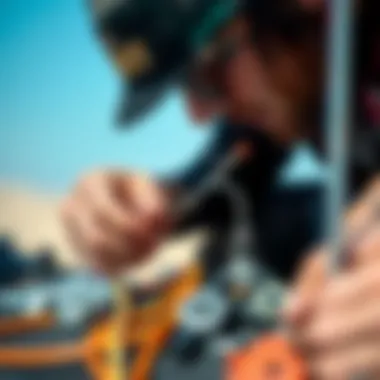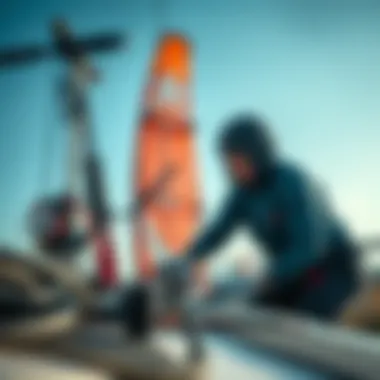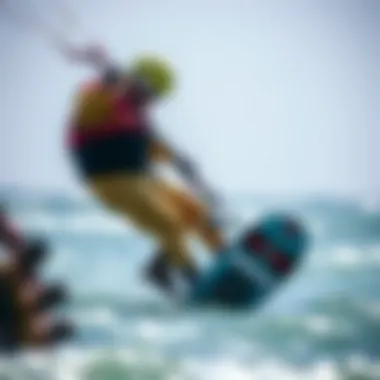Essential Insights on Kitesurf Repair Kits


Intro
Kitesurfing, that thrilling dance between wind and water, often inspires a sense of freedom and adventure. However, even the most experienced kiteboarders know that with great fun comes the potential for mishaps. Whether it’s a frayed line or a tear in the canopy, being prepared with the right tools and knowledge can make all the difference when you're out on the waves.
Repair kits are more than just a safety net; they are a bridge between a stunning day on the water and being sidelined due to unexpected equipment failures. This guide serves to illuminate the intricacies of kitesurf repair kits, diving deep into the various types, essential items, and practical maintenance tips. Each section aims to equip enthusiasts with the knowledge necessary to prolong the life of their gear and ensure safety during kiteboarding adventures.
Understanding kitesurf repair kits isn't just about knowing how to fix things. It’s about enhancing your overall experience, minimizing downtime, and keeping the spirit of adventure alive. So, let's paddle into the essentials!
Gear and Equipment
Key kitesurfing Kit Components
Whether you're a beginner or a seasoned kiteboarder, having a reliable kitesurf repair kit at hand is non-negotiable. Here are several crucial components that should find a place in your kit:
- Patches and repair tape: Strong adhesive and durable patches are critical for mending tears on the canopy or bladders of your kite. Make sure the tape is waterproof and UV-resistant to withstand the elements.
- Line spare parts: Additional lines or a repair splice kit can help you replace or mend damaged lines quickly.
- Inflation tools: A good-quality pump is essential, alongside a connector that fits your valve. Also, consider a quick-release mechanism for emergencies.
- Multi-tool: A compact multi-tool with pliers, screwdrivers, and a knife can come in handy for various adjustments and fixes while on the beach.
- First-aid solution: Accidents happen on the water. Having a simple first-aid kit can address minor cuts or scrapes, ensuring that any injury doesn’t ruin the fun.
"Preparation is the key to ensuring that setbacks become a mere footnote in your kiteboarding adventure."
Maintenance Tips for Kiteboarding Equipment
The longevity and performance of your kiteboarding gear hinge largely on maintenance. Here are some essential tips:
- Regular cleaning: After every session, rinse your equipment with fresh water to remove salt, sand, and debris. This simple step can significantly extend the lifespan of your gear.
- Storage tips: Store your kite fully deflated and away from direct sunlight. Use a cool dry space to avoid mold or deterioration of materials.
- Routine checks: Before heading out, inspect your lines, bridle, and canopy for any signs of wear. Being proactive today can save you from larger issues tomorrow.
- Seasonal care: At the end of the kitesurf season, conduct a thorough inspection and maintenance routine. Replace any worn-out parts, and ensure that you pack away your kite properly until the next season.
Techniques and Skills
Getting Started with Kiteboarding
Kiteboarding might initially seem like a dizzying array of skills and techniques, but each part is a stepping stone to mastering this dynamic sport. It's essential to grasp the basics before venturing out deeper into advanced maneuvers.
Practicing essential techniques like the safe launch and landing of your kite, body dragging, and transitioning across the board sets a solid foundation. These skills unlock the gates to more complex tricks and techniques.
Advanced Maneuvers for Experienced Kiteboarders
For those already familiar with kiteboarding, advancing to trickier maneuvers, such as jumps and spins, requires practice and finesse. Having a toolkit - in this case, both figuratively with skills and literally with repair kits, helps you push your limits without the fear of equipment failures.
Keep honing those skills and ensuring your equipment is in top shape, and you'll be riding those waves with confidence and style, no worries about unexpected equipment problems.
Foreword to Kitesurf Repair Kits
Kitesurfing, while exhilarating, can sometimes turn into a test of one's preparedness. A solid understanding of kitesurf repair kits is fundamental for both new and seasoned kiteboarders. These kits are not just a luxury; they are essential for maintaining gear in peak condition and ensuring safety on the water. The unpredictable nature of the ocean, combined with the intense elements that kitesurfers face, means that carrying a repair kit is not optional—it's a necessity.
Think about it: you're riding the waves, feeling the wind rush through your hair, when suddenly, a tear in your kite fabric threatens to ruin all the fun. Having a kitesurf repair kit handy can be the difference between an enjoyable session and a costly mishap. These kits empower you to address minor issues before they escalate, providing a sense of security. You can tackle problems like fabric tears, line issues, or bladder leaks without having to wait for professional help.
Furthermore, many kitesurfers are outdoor enthusiasts looking to push their limits. By equipping themselves with the right tools and knowledge about repair kits, they ensure their equipment stays in optimal shape, allowing for more time spent riding the wind rather than worrying about equipment failure.
When considering kitesurf repair kits, one should keep in mind not just the contents but also how the kit enhances the overall kitesurfing experience. A well-organized kit will help you feel confident and ready to tackle any potential hiccups while out on the water, thus preserving the thrill of kitesurfing for years to come.
"Being prepared is not just the first step to success; it’s the first step to safety on the water."
In summary, understanding kitesurf repair kits means acknowledging their critical role in maintaining gear integrity and promoting safe, enjoyable experiences. This article dives deeper into the essential components, the types of repairs you can perform, and when to utilize your kit—all to enhance your prowess as a kiteboarder.
The Importance of Having a Repair Kit
When you're out on the water, nothing can spoil an adrenaline-fueled day quite like a torn kite or a malfunctioning line. This is where having a kitesurf repair kit becomes not just a good idea but a necessity. The importance of being prepared with a repair kit can't be overstated, especially for those who take their kitesurfing seriously.
A kitesurf repair kit serves multiple purposes: it allows you to tackle minor repairs, ensuring that you can keep enjoying your session without a hitch. Whether it's something as simple as a frayed line or a more serious issue like a tear in the kite skin, having the right tools at your disposal can be a game-changer. Additionally, addressing small problems right away can help prevent them from escalating into more serious safety concerns later on.
Another critical reason to have a repair kit handy is that kitesurfers often find themselves far from immediate help. On the open water, help can feel like it's a million miles away. If you rely solely on professional services, you might end up wasting precious time when all you need is a quick fix to continue your adventure. Being self-sufficient not only empowers you but also enriches your overall kitesurfing experience.
Considerations for Kitesurfing Adventures
The wind and waves can be unpredictable. Therefore, a well-rounded repair kit includes items tailored to the specific types of gear you use. For instance, if you’re using a bladders kite, including bladder patches and adhesive is crucial. If you're working with traditional seam construction, don’t forget heavy-duty fabric patches as well.
In addition to standard repairs, here are some benefits of having a repair kit:
- Cost-efficiency: Avoid the expense and hassle of professional repairs for minor issues.
- Convenience: Spend more time enjoying kitesurfing rather than worrying about faulty equipment.
- Safety: A secure kite setup minimizes risks related to equipment failure, keeping you safe on the water.
To summarize, having a kitesurf repair kit is an invaluable aspect of any kitesurfer’s gear collection. It provides peace of mind, allowing you to focus on your riding instead of fretting over potential equipment failures. In the next section, we will explore the various essential components of a comprehensive repair kit, making sure you’re fully equipped for whatever your session may bring.
Always remember: Being prepared is half the battle won!
Components of a Basic Kitesurf Repair Kit
When venturing into the world of kitesurfing, having a reliable repair kit at your fingertips is as essential as the kite itself. The elements that make up a basic kitesurf repair kit are crucial for addressing various emergencies on the water, guaranteeing both safety and fun. By understanding what components are included, you can mitigate the risk of having to cut your session short due to unexpected issues. This section will shed light on the key ingredients of a comprehensive repair kit, explaining their importance and benefits for any kitesurfer.


Adhesives and Patches
Adhesives and patches are the unsung heroes of any repair kit. In a pinch, these tools can save you from an unnecessary swim back to shore. Patches, often made from durable materials like Dacron or Ripstop nylon, provide an immediate solution for holes or tears in your kite’s fabric. They help ensure that the integrity of the kite remains intact, allowing you to enjoy your time on the water without constantly worrying about leaks.
Choosing the right adhesive is equally important. A strong, flexible adhesive that can withstand water exposure—like those from brands such as Aquaseal or Tear Aid—makes repairs straightforward and can maintain a secure bond even in wet conditions.
"A stitch in time saves nine," as they say. The right patch at the right moment can mean the difference between keeping your kite airborne and a lengthy day of repairs.
Tools: What You Need
A well-equipped repair kit goes beyond just patches and glue. Tools play a vital role in carrying out effective repairs on the fly. Here’s a breakdown of what you should have in your collection.
Scissors
Scissors play a pivotal role in any repair endeavor. You’ll find yourself using them to trim patches to size or cut away excess line. A good pair of scissors should be small enough for portability but sturdy enough to handle various materials. Look for scissors with fine sharp edges, as they can offer precise cuts that prevent fraying.
Moreover, lightweight, compact options like the ones made by Fiskars are a favorite among kitesurfers because they are easy to stash yet reliable when you need them the most.|
Screwdrivers
Screwdrivers might not be the first thing that comes to mind when you think of kitesurfing, but they are indispensable when it comes to adjusting or replacing various parts of your gear. Having both Phillips and flat-head screwdrivers in your kit means you are ready for tightening screws on your bar or modifying your pump connectors.
Folding screwdriver sets, like those from Leatherman, are especially popular because they fit neatly into a small space without compromising functionality.
Tapes
Tapes are a multi-functional wonder in a repair kit. Duct tape, specifically, can serve various purposes, from quick fixes on a torn seam to securing a loose bladder. It’s strong and easy to work with, making it a go-to choice for many kitesurfers who find themselves in a bind. While some might wonder about the longevity of tape repairs, it’s worth noting that in a pinch, it can mean the difference between a damaged session and staying on the water longer.
Keep in mind, though, that tape should serve its purpose temporarily. Permanent fixes with patches and adhesives are advisable once you’re off the water.
Inflation System Replacements
Last but not least, inflation system replacements can be a gamechanger in your kitesurf repair efforts. The bladder of your kite is critical; a malfunction can lead to failed launches or erratic performance. Replacement valves and bladders should always be on hand for emergencies.
Opting for a kit that includes a variety of inflation system components ensures that when something breaks, you can swiftly replace it without fuss. If you find a tear in your inflation bladder at the beach, you don’t want to be scrambling to find a solution.
By investing in a fundamental understanding of these components, you are not only preparing for potential mishaps but also enhancing the overall longevity and performance of your kitesurfing gear.
Types of Repairs You Can Perform
Kitesurfing can be a thrilling experience, but it comes with its fair share of hazards that can lead to equipment damage. Understanding the types of repairs that you can perform is central to not just extending the life of your gear but also ensuring your safety and enjoyment on the water. Knowing how to conduct these repairs with confidence minimizes downtime and gives you peace of mind, enabling you to focus on riding the waves instead of worrying about your equipment. Below, we break down some critical repair areas that every kiteboarder should know about, as well as the methods for tackling these repairs efficiently.
Skin and Seam Repairs
The skin and seams of a kite are its first line of defense against the elements. Damage in this area can result from sharp objects, abrasive surfaces, or even a rough landing. If you notice a tear or hole, it's essential to act quickly. Not addressing such issues could compromise the kite's performance and lead to more extensive damage.
To make effective skin and seam repairs, using a strong adhesive along with special fabric patches designed for kite repair is key. Here’s how you can go about it:
- Identify the Damage: Inspect the skin for any signs of wear, punctures, or tears.
- Clean the Area: Remove any dirt or grease to ensure proper adhesion.
- Apply the Patch: Cut a patch slightly larger than the hole and apply a thin layer of adhesive. Firmly press the patch onto the damaged skin and allow it to cure as per the adhesive's instructions.
"A stitch in time saves nine." Taking the time to repair minor damages promptly can prevent them from escalating.
Maintaining the integrity of the skin not only ensures optimal performance but also enhances the reliability of the kite as you ride.
Bladder Repairs
The bladder is a vital component that keeps your kite inflated and functioning properly. Damage to this inner structure can lead to air leaks, which renders the kite unusable.
If your kite has lost pressure, follow these steps for bladder repair:
- Locate the Leak: Use a spray bottle filled with soapy water. Spray it over the bladder and look for air bubbles to find the leak.
- Mark the Area: Once located, use a marker to indicate the damaged spot.
- Prepare for the Patch: Like skin repairs, clean the area around the leak.
- Use a Repair Kit: Many kits include clear patches specifically designed for bladders. Seal over the marked area with a patch, ensuring it overlaps the hole adequately.
For best results, allow adequate time for the adhesive to cure. Taking these steps will help you get back on the water without spending money on professional repairs.
Line Repair Techniques
Lines take a beating against the elements and can encounter abrasions, fraying, or even breakage during use. Understanding how to maintain and repair these lines is crucial for safe kite flying.
Here’s a breakdown of line repair methods:
- Inspect Regularly: Conduct routine checks for frays or damaged sections of the lines.
- Splicing: If you find a compromised section, consider using a splicing technique to connect both ends of the damaged line. With the right kit, splicing can restore the line's integrity.
- Replacement: Sometimes, replacing a line is the best option. Make sure you have spare lines with the same specifications as your original equipment.
To tie it all together, keeping an eye on your lines can save you from potential mishaps on the water.
Being knowledgeable about these repair types arms you with the practical skills necessary to handle common issues, making your kitesurfing experience smoother and more enjoyable.
When to Use Your Repair Kit


Having a kitesurf repair kit close at hand isn't just a convenience; it can be the difference between a successful day on the water and an untimely return to shore. Understanding when to reach for that kit is crucial for any kiteboarding enthusiast. Think of it like preparing a safety net before walking a tightrope; you wouldn’t want to find out you have gaps in your safety equipment mid-performance.
Pre-emptive Maintenance
Timing is everything, especially when it comes to gear. One of the smartest moves a kiteboarder can make is to undertake pre-emptive maintenance. This involves inspecting your kite and gear before the adventure begins. Look for wear and tear in areas like seams or bladder attachments because nobody wants a kite that’s letting air out faster than it can inflate.
- Make it a habit to check your kite's leading edge, struts, and lines for any inconsistencies.
- Replace any worn or frayed lines before they become a bigger issue on the water.
- Keep your repair kit within easy reach in your travel bag or your vehicle. You never know when you might notice something needs fixing.
By staying one step ahead, you're ensuring that minor issues don’t snowball into major repairs, which might leave you high and dry on the surf.
On-water Repairs
There comes a time during a session when the unexpected happens—a rogue gust, an unfortunate snag, or that gasp-inducing snag when you least expect it. Knowing how to conduct on-water repairs is paramount. Your repair kit isn't just a backup; it’s your immediate solution in the moment of crisis.
- Identify the problem quickly: The faster you pin down an issue, like a small puncture or seam failure, the fewer precious minutes you’ll lose.
- Utilize quick patches or adhesive: The right adhesive can be a game-changer. A simple action like applying a patch can often allow you to continue riding.
- Stay calm and focused: Keeping a level head will help you assess the situation. Panicking might just lead to worse damage or, worse, an accident.
In short, knowing when to use your repair kit and how to act swiftly can often mean the difference between continuing your fun on the water and an abrupt end to your day. Remember, every minute spent dealing with gear issues could be a minute more riding the waves.
Even the best kiteboarders encounter equipment setbacks. What matters is your preparedness and how efficiently you address those issues.
Choosing the Right Repair Kit for Your Needs
Selecting the right kitesurf repair kit isn’t only a matter of convenience; it's an essential aspect of ensuring your time on the water remains enjoyable instead of problematic. Knowing your needs, based on the type of kite you own and how often you hit the waves, can significantly influence your choice. An understanding of these factors helps you prepare for unexpected mishaps, bearing in mind the nature of kitesurfing itself—mainly, it’s unpredictable.
A quality repair kit can spell the difference between a day spent stranded on the beach and one spent zipping across the water. Thus, attention to detail is crucial when picking the right kit. Let’s break down key factors to consider, starting with the type of kite, followed by how frequently you kiteboard.
Factors to Consider
Type of Kite
The type of kite you have plays a pivotal role in determining the specific repair kit you’ll need. Kites come in various shapes and sizes, each tailored for different styles and conditions, such as:
- Foil Kites: Often preferred for their efficiency in low winds, these kites present unique sealing materials that might require specialized patches.
- LEI (Leading Edge Inflatable) Kites: These are more common and widely used in the kitesurfing community. They rely on a bladder that holds the air; thus, your kit should contain materials suited for bladder repairs.
The principal characteristic of the LEI kite is its inflatable leading edge. This allows for better performance and stability, but a puncture in the bladder can end your session abruptly. On the other hand, foil kites, while needing less maintenance, can be a bit tricky during repairs since their structure involves multiple layers. The unique feature here is that their repairs may be less focused on inflating systems, but rather on skin materials. Choosing a kit designed with these considerations can make all the difference.
Usage Frequency
Next, consider the frequency with which you use your kite. If you're among the fortunate who can catch the breeze every weekend, your repair kit definitely needs to be more robust.
In this context, the key characteristic of high-usage patterns is wear and tear. A kiteboarder who frequently enjoys their time on the water is bound to encounter things like abrasions, loosed seams, or even breaks. An extensive kit with various patches, adhesives, and tools will serve this user well, as they might also bear the brunt of mishaps more often.
Conversely, if your outings are more sporadic, a lighter kit could suffice. The unique feature here is the balance of preparedness versus practicality; while a smaller kit is easier to carry, it might leave you unprepared for unexpected damages. Finding a middle ground is key for your own comfort and safety.
A well-chosen repair kit not only enhances your protection on the water but builds your confidence to go out and ride any wave.
Professional Repair Services vs. DIY
The debate between professional repair services and DIY fixes often comes down to expertise versus convenience. Kitesurfers know that, with the right gear, the thrill of gliding over water can quickly turn into a disaster if something goes awry. In this scenario, having a repair kit handy is as vital as the kite itself. However, this leads to a crucial question: should you tackle repairs on your own, or seek out a professional?
Pros and Cons of DIY Repairs
For many kiteboarders, DIY repairs offer a sense of autonomy and cost savings. Here are some benefits and drawbacks:
Benefits of DIY Repairs
- Cost-effective: Fixing your kite can save you money, especially if you frequently repair small damages.
- Immediate Action: When you’re out on the water and something's off, being able to make quick fixes means you can get back to enjoying your session.
- Learning Experience: With each repair, you gain valuable knowledge that might help you in the future, both in maintenance and handling emergencies.
Drawbacks of DIY Repairs
- Skill Level Required: Not everyone is equipped to handle more complex repairs, like bladder issues or intricate seam work.
- Risk of Further Damage: A poorly done repair can worsen the initial issue, costing more in the long run.
- Time-consuming: If you’re unfamiliar with the repair process, it might take longer than anticipated, interrupting your plans.
When to Seek Professional Help
While DIY repairs have their perks, there are situations where professional intervention is necessary. Recognizing these scenarios can save you from extended downtime and bigger issues down the road:
- Complex Damage: If your kite has a significant tear or the bladder is damaged, nailing these repairs usually requires specialized skills that only professionals possess.
- Lack of Tools or Materials:Sometimes, the tools needed for effective repairs are not readily available, making it impractical to undertake a fix.
- Time Constraints: If you rely on your kite for teaching or professional gigs, you may not have the luxury to spend time learning repairs. Sending it to a pro might be the quickest solution to ensure your gear is ready.
- Warranty Concerns: Some brands offer warranties that might be voided if repairs are performed independently. It can pay off to utilize professional services in these cases.
Choosing the right approach ultimately comes down to the level of damage, your own skills, your kit's warranty, and what you feel comfortable doing. Find the sweet spot that works for you, ensuring the best performance out of your kitesurfing gear.
The right approach of repair ensures not just the functioning of your gear but enhances the longevity of your investment.
For more insights on kitesurfing gear and maintenance, visit Kiteforum or check out relevant discussions on Reddit.
Maintaining Your Kitesurf Repair Kit
Having a well-organized and maintained kitesurf repair kit is as crucial as the gear you use on the water. First off, it saves time and prevents frustration when an urgent fix is need, which can quickly turn a perfect day into a long wait if you are unprepared. Picture this: you’re gliding over the waves, enjoying the wind in your hair. Suddenly, the rip of a seam or a puncture puts the brakes on your session. Most kitesurfers know, if you can fix it right away, you’ll probably be back in action before the wind changes its mind.


The primary benefit of maintaining your repair kit is reliability. You want to ensure that all components—adhesives, tools, and patches—are ready to go when you need them. A well-kept kit can make all the difference, not just for your gear, but also for your adventure lifestyle. Without regular checks and updates, you risk running into ineffective solutions that could leave you high and dry.
Checking Supplies Regularly
Checking the contents of your kit regularly might sound like a chore, but consider it part of your overall routine. Just like you check your gear before hitting the water, give your repair kit the once-over. This isn’t just basic upkeep; it’s your insurance policy against breakdowns. You wouldn’t drive a car with a flat tire, so don’t head out on the water with a lackluster repair kit.
A few things to look out for:
- Expiry Dates: Some adhesives and patches can go bad. Check for dates and dispose of any expired items.
- Quantity of Supplies: Ensure you have enough patches and adhesive. During peak season, you don’t want to be caught short.
- Functionality of Tools: Scissors should cut cleanly. If they’ve dulled, replace them. A faulty tool can worsen a minor issue.
Establish a habit of taking a look every month or so, especially during the busy kitesurfing season. A well-stocked kit gives peace of mind, allowing you to focus on the exhilarating moments, instead of scrambling to patch things up.
Updating Your Kit
An empty space in your repair kit can turn into a liability. Alongside checking supplies, updating your kit keeps it relevant to your current needs. Your riding style and the conditions you face on the water may change, and so should your repair kit.
Start by reviewing what repairs you’ve performed recently. If bladder repairs have been your most common fix, ensure you have the right materials for future occurrences. Similarly, if water-resistant tape has become a common necessity in your sessions, make sure you have ample rolls ready.
Moreover, consider including new items based on emerging trends or experiences. For instance, if you find a particular brand of adhesive or sealant works wonders, add it to your regular reserves. Likewise, read up on recent innovations in kitesurfing materials to keep your kit ahead of the curve.
To assist in updating your kit, here’s a small list to consider adding or replacing on a regular basis:
- Quality Adhesive: Always opt for a strong and waterproof option. Brands like Tear Aid have been a reliable choice for many.
- Extra Patches: Carry various sizes suitable for different kite types—surf, foil, etc.
- Portable Tool Set: Compact and efficient, it saves space and is quick to access.
In the end, keeping your repair kit fresh and fit may feel like a minor task, but neglecting it can lead to bigger headaches later.
"An ounce of prevention is worth a pound of cure." — Benjamin Franklin
Ultimately, a proactive approach to maintenance will not only enhance your kitesurfing experience but also foster a deeper connection with the sport itself.
Storing Your Repair Kit Effectively
An often overlooked aspect of kitesurf repair kits is their storage. Just like any important gear, how you store your repair kit can make a world of difference in its effectiveness when you need it most. Organizing your repair items not only ensures that everything is in one place but also that it’s in good condition when needed.
Proper storage can save time during emergencies and maximize the lifespan of your repair supplies. Imagine being out on the water and needing to fix that pesky tear or a stubborn bladder issue. A well-organized kit means you’re not rummaging around or panicking; instead, you're prepared and focused on fixing your gear.
Optimal Storage Conditions
When it comes to storing your repair kit, conditions matter. Kitesurfing gear and its components can be sensitive to extremes of temperature, humidity, and sunlight. For instance, adhesives can lose their effectiveness if exposed to excessive heat. On the other hand, moisture can lead to mold or affect the integrity of materials such as tape and patches.
- Choose a Cool, Dry Location: A climate-controlled area, away from direct sunlight, is ideal. A garage or a dedicated storage shelf can do the trick.
- Avoid Humid Spaces: Don’t stash your kit in the bathroom or kitchen, where humidity levels fluctuate wildly.
It’s also practical to consider the container. Ideally, use a waterproof box. This not only protects against moisture but also dust and dirt that can compromise your gear. If you want to make a truly bomb-proof kit, label everything clearly, so you know what’s where. No one wants to dig through a hodgepodge of items when time is of the essence.
Portable vs. Fixed Storage Options
The choice between portable and fixed storage depends on your individual needs and kiting habits.
- Portable Storage Options: If you’re often on the move or traveling to different kitesurfing spots, a portable kit makes the most sense. Consider a compact, waterproof bag or a travel-sized storage container. They’re designed for easy transport, and you can keep a basic set of tools and supplies handy.
- Fixed Storage Options: On the flip side, if you usually kite in one area or have a dedicated space for your kitesurfing gear, fixed storage can be beneficial. A sturdier, larger box can house more items, and you can take the time to organize your kit thoroughly. This arrangement is less likely to go missing, however, it can be cumbersome if you decide to change locations frequently.
Ultimately, the choice comes down to your lifestyle. A versatile approach combining both storage options can cater to spontaneous adventures while ensuring you’re prepared for longer sessions as well.
"A well-prepared kitesurfer is never caught off guard." – Anonymous
Finale and Best Practices
In the world of kitesurfing, equipment reliability is paramount. As kiteboarders take to the water, they put not just their skills but also their gear to the ultimate test. Therefore, maintaining a repair kit becomes not just a good practice but a necessity. The conclusion of this guide emphasizes several aspects about having and managing a kitesurf repair kit effectively.
Importance of Being Prepared
While the thrill of riding the waves can be exhilarating, it’s crucial to recognize that complications can arise at any time. Whether it’s a small tear in the fabric or an unexpected hardware failure, these problems can quickly escalate and ruin a day of fun. A well-stocked repair kit stands between you and a long wait by the shore, offering the tools and resources necessary to address minor issues before they become major mishaps.
Regular Maintenance Check
As a kiteboarder, you shouldn't wait for an emergency to check your supplies. It's a best practice to routinely assess your repair kit before each season or significant trip. This ensures the availability of critical items such as adhesives, patches, and specialized tools. By keeping an eye on inventory, you can easily replace anything that seems to have disappeared, ensuring that you are never caught unprepared.
Mastering DIY Skills
Understanding how to perform basic repairs empowers kitesurfers. Whether it's fixing bladder issues or mending seams, learning these techniques adds a layer of confidence when catastrophe strikes out on the water. Videos and tutorials online offer guidance for honing these skills, which can prove invaluable in sticky situations.
Balancing DIY with Professional Help
While many repairs can be handled independently, some situations call for professional intervention. Knowing your limits is essential. If you face extensive damage, consulting an experienced technician is wise. They possess the specialized tools and knowledge to restore your gear properly.
Optimal Storage for Easy Access
Remember, how you store your repair kit can affect your quickness in responding to a mishap. Keeping it in a dry, easily accessible spot ensures that you can reach for it without fuss when you need it most. Consider using a waterproof bag that keeps everything in one place, ready to go; no more digging through a jumbled bag when the waves are calling!
"An ounce of prevention is worth a pound of cure."
Finale
Ultimately, maintaining a kitesurf repair kit is not just about having the right tools; it’s also a mindset. Caring for your equipment, staying organized, and being prepared turn an uncertain outing into an enjoyable adventure. This guide, with its detailed components and best practices, aims to equip you with the knowledge to keep your gear in top shape and ensure safety while you ride the waves. Remember, the best surfer is the one who can handle whatever surprises come their way!















